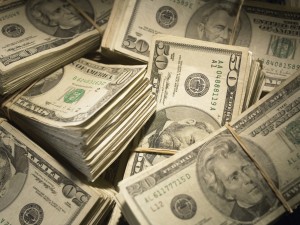What is the US Fed interest rate and why is it so important?
 There are two ways banks obtain short term capital to meet minimum reserve requirements: they either borrow directly from the Federal Reserve or from another bank. Borrowing from the Central bank has been the more expensive option as the cost of doing business with the bank – the discount rate set by the Fed – has been slightly higher than the Federal Funds rate (the interest rate banks charge one another for overnight loans) for the past decade.
There are two ways banks obtain short term capital to meet minimum reserve requirements: they either borrow directly from the Federal Reserve or from another bank. Borrowing from the Central bank has been the more expensive option as the cost of doing business with the bank – the discount rate set by the Fed – has been slightly higher than the Federal Funds rate (the interest rate banks charge one another for overnight loans) for the past decade.
Traders and economists alike monitor the Federal Funds rate as it is the lowest short term interest rate available on the market and widely considered to be among the most important factors for stimulating or stalling the economy. While the Fed does not set the Federal Funds rate, the two rates are strongly correlated. In other words, moving the discount rate up or down influences a similar movement in the Federal Funds rate.
Who makes the decision to change the interest rate?
The FOMC (Federal Open Market Committee) is responsible among other things for setting the discount rate. This group consists of 12 governors, one from each Federal Reserve District, and meets every 8 weeks to determine and review fiscal policy. The FOMC is chaired by Janet Yellen.
The challenge
Increased rates are imposed to tighten the supply of money. Simply put, as the cost of borrowing increases, it becomes too expensive for certain businesses to borrow capital. For this reason, increased rates are generally thought of as limiting to new business opportunities and discourage businesses from hiring.
Lower rates on the other hand, increase the supply of money. When the cost of borrowing is cheap or even affordable, businesses that wouldn’t ordinarily consider taking out a loan or expansion will consider new opportunities. On a macroeconomic level, lower rates are considered to be expansive and stimulating to the economy whereas higher rates are often associated with a contracting economy and are the Fed’s way of telling people to tighten up.
The challenge from the Fed’s perspective is if it constantly holds the discount rate low, which has been the case since 2008, the value of money decreases.
Current Market Situation
The question of “will the Fed hike the interest rate?” seems to be a question of when not if. Since late 2008, the Fed Funds Rate has been at historic lows, ranging from 0.00% – 0.25%. Janet Yellen, leader of the Fed, mentioned on the podium back in September, that in late 2015 a hike would likely be appropriate. To some, this marked the beginning of the Fed’s move back towards its stated 2% objective for the inflation rate (which is also currently near 0%). The inflation rate, like the Federal Funds rate, is usually increased by raising short term interest rates.
In the Fed’s most recent meeting in October rates were not raised which did not come as a surprise, but the topic of a rate hike was brought up as something to be addressed at the FOMC’s next meeting in early December.
Some contend that this is turning into a case of the boy who cried wolf and that a rate hike is not likely to happen this year or even next as the market has been entirely too volatile throughout 2015 and labour reports as recent as September were weak. Others surmise that a gradual increase is imminent and that the coming report will feature a rate hike of 25 basis points (0.25%). Due to concerns of the adverse effects of raking up rates too quickly, even those calling for a raise in December expect the hike to be done gradually.